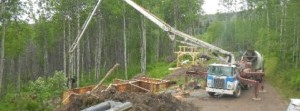
Avoiding the plaster disaster
It’s been said many times that homebuilding is the highway to divorce.
For us, it’s been the opposite. Nick and I started to talk building right after he moved in, six weeks after we started dating. As we drew out our floor plans, we were designing our lives together. As each timber went up, we felt stronger. With every stacked bale, more secure.
Until we started plastering.*
Plastering, as it turns out, is where progress bogs down. For the last two months, we’ve been stuck in the mud. But let’s back up.
A year and a half ago, when we were first researching our house, we went to visit Hans Duerichen, a local innovator and the inventor of RSF woodstoves. Hans created and installed a biomass burner, which heats his home just outside Smithers with sawdust cast off from a local saw mill. As it turns out, Hans is an engineer who has worked with straw bale construction in the Kootenays.
Because straw bale—as well as timber frame—construction is outside the building code, we’d been on the lookout for someone to engineer our house. We had just found the perfect candidate.
Hans was also supportive of using clay in our plaster. Nick knew from the beginning he wanted to use clay plaster to cover our straw bales. Concrete is commonly used, but doesn’t breathe as well; as a result, any moisture trapped in the bales is likely to stay there.
Unlike concrete, a known and highly studied entity, clay is quite variable. We needed guidance on what clay to use, how to mix it, and how to apply it. Hans connected us with Cindy Walker, a natural plaster expert from New Denver, B.C. Cindy quickly became known as the plaster master.
Clay is buried all over the Bulkley Valley. It turns up when it’s least wanted, usually when digging basements or septic systems. It’s often cursed by those who uncover it. But when you’re on the search for a dump truck load, it can be difficult to find.
You don’t just pick up the phone and order a load of clay. For the most part, it has very little marketable value and, as a result, there are few avenues for acquiring large loads of it. We could have ordered it bagged from Alberta, for the price of an all-expense-paid trip to Europe.
I made a “local clay wanted” sign for the end of the driveway. I talked to friends. I posted on Facebook. I called local excavating companies in the hopes they would remember us the next time they turned up clay in someone’s basement. But it was a Google Earth document sent from a friend in government that gave us our lead.
The Google Earth file showed three deposits in Smithers, but the problem was getting a truckload. Many deposits are exposed by rivers slicing through layers of sediment; but one doesn’t just pull a dump truck into a fish-bearing river. Others deposits were on government land. There was one on private property.
I looked closer at the map. This one deposit, right in town, was described as an old brick factory. Now it’s a vacant lot—one owned by Andrew Watson, whose crane we hired to lift our timbers into place. Andrew also has an excavator and a dump truck. It seemed too good to be true.
Fortunately, Andrew happily agreed and we had two dump truck loads of clay delivered shortly after.
Next came the hard part—turning it into our plaster walls. The process takes several coats: The first is a sloppy “slip” coat, roughly the consistency of chocolate pudding, which is slathered on the bales and coats the straw, helping the plaster coat to stick. Slip can be applied using a spray gun, but because we’d chosen clay from the ground—rather than a bag—Cindy wasn’t sure it would be smooth enough for the sprayer.
As we slapped on the slip coat, someone would follow closely behind applying the plaster: a mix of slip, sand and mulched straw. The first coat goes on rough and uneven, helping the subsequent coat to stick. Again, it is all applied by hand.
Next comes a second coat of plaster, which is troweled using a wooden float. This is when things get exciting: the smooth plaster walls have the look of velvet with beautifully rounded corners. This is the part that’s just finished, but we’re not done: a final, smoother plaster coat—with finer sand and straw—goes on last.
I expected the process to take a week, maybe two. It took two months.
Needless to say, there were moments of frustration. There were times when tensions ran high and maybe some people got grumpy.
Fortunately, the process is incredibly forgiving. It allows you to smooth over rough edges, gently contour imperfections and fix past mistakes. You keep working at it and, slowly over time, you create the beautiful thing you first envisioned.
As it turns out, the same goes for plaster.
*Nick would like it noted that this is an over-dramatization of actual events.
http://strawbaletales.wordpress.com/






